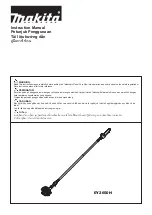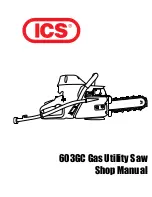
14
On / Off Switch
Do not use any device where the switch can not be
switched on and off. Damaged switches must be repaired
or replaced immediately by the customer service.
Switch on
Press the green button ( I ) on the switch.
If there is a power cut, the machine switches off
automatically. To switch on again, press the green ( I )
button.
Switch off
Press the red button ( O ) on the switch.
Motor protection
The motor is equipped with a safety switch and
switches off independently when overloaded.
It can be switched back on following cooling phase (5 -
10 min.).
First press
1.
small button (17)
2.
the green button ( I ) to start
Dust/chip exhaustion
The wood dust generated during operation impedes
the necessary view and is harmful to health to some
degree.
Unless the machine is used outdoors, it must be connected to a
chip exhaust system (e.g. portable dust remover).
Chip exhaustion
Connect a chip exhaust system or small vacuum cleaner
with suitable adapter to the chip exhaust neck (18) (Ø 40 mm).
Air velocity at the exhaust neck of the saw
≥
20 m/sec.
Use a special exhaust device when exhausting dusts that are
harmful to health, carcinogen or dry.
Adjusting the saw
Pull the mains plug before performing
settings.
Adjusting the riving knife
The riving knife is an important safety device as it
prevents the workpiece from recoiling.
Always use the supplied riving knife.
To ensure the function of the riving knife its clearance to
the saw blade teeth must be correctly adjusted.
Adjusting the riving knife
For information on how to adjust the riving knife see the chapter
"Maintenance
Changing the saw blade".
Set the cutting height
The cut height can be adjusted stepless from 0 - 85
mm using the crank (6).
Before adjusting the cutting height, tighten the locking
screw for incline adjustment (15).
Set the cutting height 5 mm higher than the material
thickness.
Adjust saw blade pitch
The saw blade must not be set to the inclined
position when the blade is turning. The motor must
be switched off first.
Adjusting between 0° - 45°
1.
Loosen the clamping screw (15).
2.
Turn the handwheel until the required angle is shown (0° -
45°).
3.
Retighten the clamping screw (15).
Fitting and adjusting the transverse stop
The transverse stop supplied can be used as a
transverse or mitre stop.
Make sure that the stop is correctly adjusted (see
"Working with the saw").
Fit the transverse stop to the saw table plate
Push the transverse stop (11) into one of the two grooves
on the saw table plate.
Setting the angle
Loosen the clamping screw (B) of the transverse stop (11)
by turning. You can now set the stop to the required angle. Turn
the clamping screw tight again.
Summary of Contents for T 250 Eco-3
Page 30: ...29 DIN EN ISO 3744 LWA 107 dB A LpA 94 dB A 3 dB II E 2012 19 EC MDF HM EN 847 1 250 mm HSS...
Page 32: ...31 2 4 3 4 3 29 27 27 5 6 12 A 8 8 3 8 mm A 7 8 B 9 7 18 11A 19 HSS 30 mm HSS EN 847 1...
Page 34: ...33 0 45 1 15 2 14 0 45 3 15 11 C 11 13 D 13 25 25 1 13 24 2 25 3 150 19 30 mm 24A 50 mm...
Page 35: ...34 361700 300 400 mm 80 100 mm 15 20 mm 11 11 HSS 7 12 30 31 31 23 22 5 5 6 8 3 8 mm A A...
Page 36: ...35...
















































